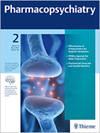Cortical and subcortical grey matter volume alterations in neuropsychiatric long-COVID syndrome episode
IF 3.6
3区 医学
Q2 PHARMACOLOGY & PHARMACY
引用次数: 0
Abstract
Introduction Neuropsychiatric symptoms are among the most common sequelae of long-COVID-19 and highly diminish the patient's quality of life. As accumulating evidence suggests an impact of survived SARS-CoV-2-infection on brain physiology, it appears necessary to further investigate brain structural changes in relation to clinical long-COVID symptoms. Understanding the pathogenic processes in neuropsychiatric long-COVID will be vital to identify targeted therapy and to ease the months long-lasting symptoms. Methods The present cross-sectional study investigated 3T-MRI scans from long-COVID patients (n=30) with neuropsychiatric symptoms, and healthy controls matched for age and gender (n=20). Whole-brain comparison of grey matter volume (GMV) was conducted by voxel-based morphometry using the CAT12 software package. To determine whether changes in GMV are predicted by neuropsychiatric symptom burden and / or initial severity of symptoms of COVID19 and time since onset of COVID-19, we performed multiple linear regression analysis. Results Enlarged GMV in long-COVID patients was present in several clusters (p<0.05, FWE- corr-ected) spanning frontotemporal areas, insula, hippocampus, amygdala, basal ganglia, and thalamus in both hemispheres when compared to controls. Time since onset of COVID-19 was a significant regressor in three of these clusters (anatomically located in right inferior frontal gyrus, lateral and posterior orbital gyrus, anterior parts of the insula, left superior, middle and inferior temporal gyrus and left postcentral and precentral gyrus). Conclusion Grey matter alterations in limbic and secondary olfactory areas are present in neuropsychiatric long-COVID patients. Some GMV alterations were inversely associated with time elapsed since acute COVID-19, suggesting higher GMV with shorter time since onset of COVID-19. Detection of associations between GMV and clinical symptoms might be difficult, because of heterogenous clinical presentation. Larger samples and longitudinal data in neuropsychiatric long-COVID patients are required to further clarify the mediating mechanisms between COVID-19 and GMV.神经精神长期covid综合征发作的皮层和皮层下灰质体积改变
引言神经精神症状是长期COVID-19最常见的后遗症之一,严重降低了患者的生活质量。随着越来越多的证据表明,存活下来的严重急性呼吸系统综合征冠状病毒2型感染对大脑生理学的影响,似乎有必要进一步研究与临床长期新冠肺炎症状相关的大脑结构变化。了解神经精神长期新冠肺炎的致病过程对于确定靶向治疗和缓解持续数月的症状至关重要。方法本横断面研究调查了有神经精神症状的长期新冠肺炎患者(n=30)和年龄和性别匹配的健康对照组(n=20)的3T-MRI扫描。使用CAT12软件包,通过基于体素的形态测量法进行灰质体积(GMV)的全脑比较。为了确定GMV的变化是否通过神经精神症状负担和/或COVID症状的初始严重程度19和新冠肺炎发病后的时间来预测,我们进行了多元线性回归分析。结果与对照组相比,长期新冠肺炎患者的GMV增大出现在横跨额颞区、岛叶、海马、杏仁核、基底节和丘脑的几个集群中(p<0.05,FWE-相关)。新冠肺炎发病后的时间是其中三个集群(解剖学上位于右额下回、眶外侧回和眶后回、岛岛前部、左颞上回、颞中下回以及左中央后回和中央前回)的显著回归。结论神经精神长期新冠肺炎患者存在边缘和次级嗅觉区灰质改变。一些GMV变化与急性新冠肺炎后的时间呈负相关,表明新冠肺炎发病后GMV较高,时间较短。由于临床表现的异质性,检测GMV与临床症状之间的相关性可能很困难。需要对神经精神长期COVID患者进行更大的样本和纵向数据,以进一步阐明新冠肺炎与GMV之间的介导机制。
本文章由计算机程序翻译,如有差异,请以英文原文为准。
求助全文
约1分钟内获得全文
求助全文
来源期刊

Pharmacopsychiatry
医学-精神病学
CiteScore
7.10
自引率
9.30%
发文量
54
审稿时长
6-12 weeks
期刊介绍:
Covering advances in the fi eld of psychotropic drugs, Pharmaco psychiatry provides psychiatrists, neuroscientists and clinicians with key clinical insights and describes new avenues of research and treatment. The pharmacological and neurobiological bases of psychiatric disorders are discussed by presenting clinical and experimental research.
 求助内容:
求助内容: 应助结果提醒方式:
应助结果提醒方式:


